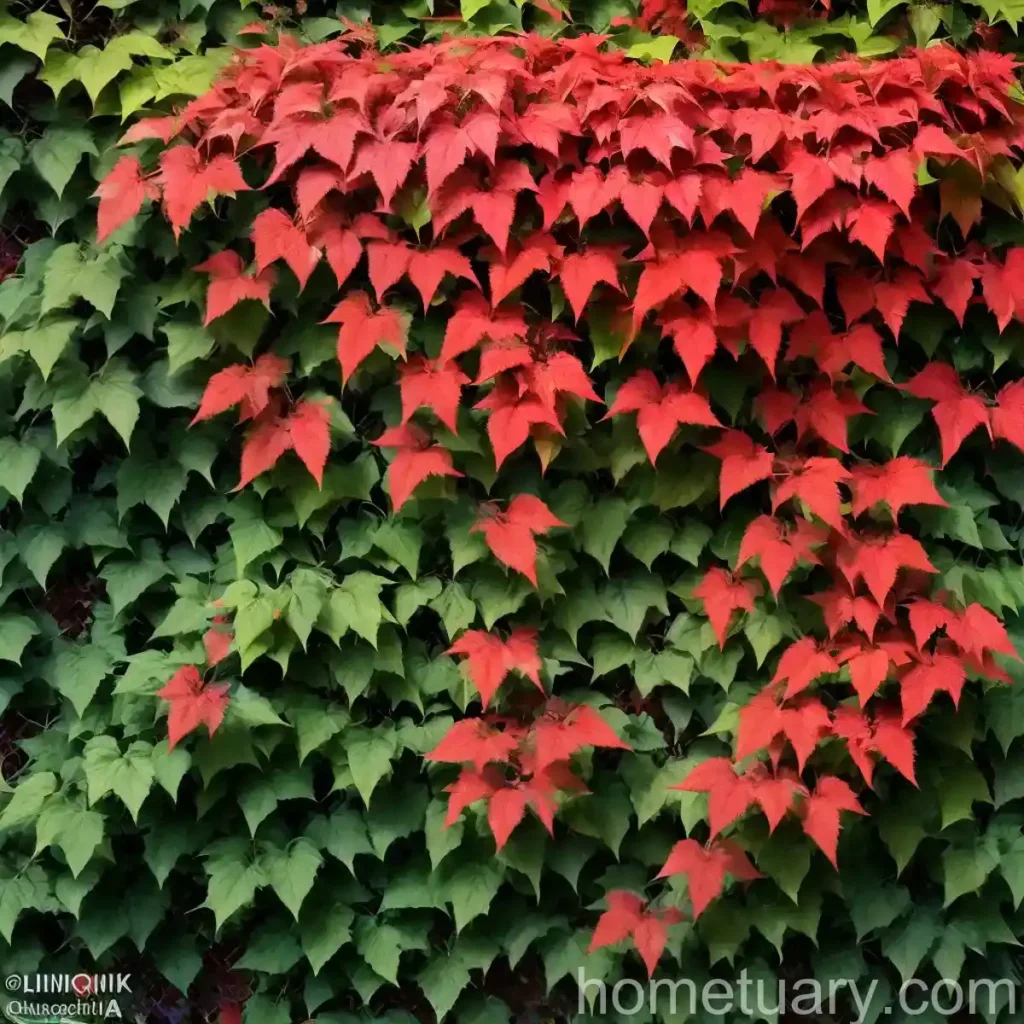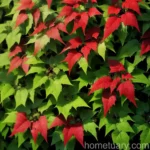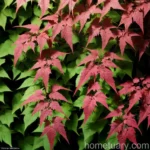Virginia Creeper (Parthenocissus quinquefolia ‘Troki’ RED WALL)
Welcome to our comprehensive guide to the fascinating world of Virginia creeper, specifically the Parthenocissus quinquefolia cultivar ‘Troki’ RED WALL. Within this detailed article, we will explore all aspects of this captivating plant, from its unique characteristics and preferred growing conditions to its common uses, care requirements, and potential challenges. Whether you are already an avid gardener or looking to embark on a new plant-growing adventure, this article aims to equip you with the knowledge and confidence to cultivate and enjoy the beauty of the Virginia creeper.
What is Virginia Creeper (Parthenocissus quinquefolia ‘Troki’ RED WALL)?
Virginia creeper is a deciduous, woody vine known for its vigorous growth, vibrant foliage, and impressive ability to climb and cover vertical surfaces. The Parthenocissus quinquefolia cultivar ‘Troki’ RED WALL, in particular, is valued for its striking red and bronze autumn foliage, making it a popular choice for adding seasonal interest to gardens and landscapes.
Key Takeaways – Virginia Creeper (Parthenocissus quinquefolia ‘Troki’ RED WALL)
Before we delve into the finer details of growing and caring for Virginia creeper, let’s take a moment to highlight the key takeaways regarding this captivating plant:
- Plant Name: Parthenocissus quinquefolia ‘Troki’ RED WALL
- Common Names: Virginia Creeper, Red Wall vine
- Characteristics: Vigorous climber, vibrant red and bronze autumn foliage
- Uses: Ornamental vine, ground cover, vertical greening
- Cultivation: Hardy, adaptable to various conditions
- Challenges: Potential for aggressive growth, requires regular maintenance
Now, let’s embark on a journey to uncover the intricacies of growing and nurturing Virginia creeper, from its preferred cultural conditions to its maintenance and potential applications.
Culture
Understanding the cultural preferences and requirements of Virginia creeper is essential for successfully cultivating and maintaining this striking vine. From ideal growing conditions to potential uses, this section will provide you with valuable insights into the cultural aspects of Parthenocissus quinquefolia ‘Troki’ RED WALL.
Uses
Virginia creeper, particularly the ‘Troki’ RED WALL cultivar, offers a wide range of potential uses within garden and landscape settings. Its most notable applications include:
- Ornamental Vine: The vigorous climbing habit and vibrant foliage make Virginia creeper a popular choice for adorning walls, fences, and trellises.
- Ground Cover: When allowed to spread along the ground, Virginia creeper can create a lush, green carpet, adding texture and visual interest to outdoor spaces.
- Vertical Greening: Due to its ability to rapidly cover vertical surfaces, Virginia creeper is often used to add greenery to structures such as buildings and arbors.
Understanding these potential uses can guide you in selecting suitable locations and design concepts for incorporating Virginia creeper into your outdoor spaces.
Water
As with any plant, providing appropriate water is crucial for ensuring the health and vitality of Virginia creeper. While this vine demonstrates a degree of tolerance to different moisture levels, it generally thrives in well-draining soil that remains consistently moist but not waterlogged. During periods of establishment and extended dry spells, regular watering is essential to support healthy growth and foliage development.
Sunlight
In terms of sunlight requirements, Virginia creeper is known for its adaptability and can thrive in a range of light conditions. While it prefers full sun to partial shade, it can also tolerate shadier environments, making it a versatile option for various garden settings. However, to encourage the most vibrant autumn foliage, providing ample sunlight is recommended.
Fertilizer
When it comes to fertilizing Virginia creeper, a balanced, all-purpose fertilizer can be applied in spring to promote robust growth and foliage development. Additionally, incorporating organic matter into the soil during planting or mulching with organic materials can provide essential nutrients and support the overall health of the vine.
Soil
The soil preferences of Virginia creeper align with its adaptability, as it can thrive in a range of soil types, including loamy, sandy, and clay soils. However, well-draining soil with a slightly acidic to neutral pH is generally preferred. Ensuring adequate soil moisture and incorporating organic matter can contribute to optimal growing conditions for this resilient vine.
Pruning
Pruning plays a vital role in managing the growth and appearance of Virginia creeper, particularly in the case of the ‘Troki’ RED WALL cultivar. Regular pruning can help control its vigorous climbing nature and encourage desired growth patterns while preventing potential issues such as overgrowth and congestion. Furthermore, pruning can be employed to maintain the overall health and aesthetic appeal of the vine, as well as to manage its size and spread within the designated space.
Propagation
The propagation of Virginia creeper, including the ‘Troki’ RED WALL cultivar, can be achieved through several methods, such as stem cuttings and layering. These techniques allow for the production of new plants from established specimens, providing opportunities to multiply and share the beauty of Virginia creeper with fellow gardening enthusiasts. Understanding the principles and techniques of propagation can empower you to expand your collection of these captivating vines.
Container Popularity
Virginia creeper, particularly the ‘Troki’ RED WALL cultivar, is well-suited for container cultivation, offering a versatile option for those with limited outdoor space or a preference for controlled growth. Its vigorous climbing habit and captivating foliage make it an attractive choice for adorning balconies, patios, and other outdoor areas, adding a touch of greenery and visual interest to urban and compact environments.
Container Common Diseases
While container cultivation can offer numerous benefits, it also poses unique challenges, such as potential disease issues. For Virginia creeper grown in containers, common diseases to watch out for include powdery mildew, which can manifest as a powdery white coating on the foliage, as well as leaf spot diseases that may cause spotting or discoloration. Adopting appropriate cultural practices and maintaining optimal growing conditions can help mitigate the risk of these diseases.
Disease Diagnosis
When caring for Virginia creeper, including the ‘Troki’ RED WALL cultivar, it is important to remain vigilant for signs of potential diseases and be prepared to take proactive measures to address them. Common issues to watch out for include:
- Powdery Mildew: A fungal disease that can affect the foliage, presenting as a powdery white coating.
- Leaf Spot Diseases: Various fungal and bacterial infections can cause spotting, browning, or discoloration of the leaves.
By being attentive to the health and appearance of the vine, you can promptly identify and address any disease issues that may arise, thereby supporting its overall well-being.
Common Pests
Virginia creeper is generally considered resistant to most pests, making it a low-maintenance option in terms of pest management. However, it may occasionally attract certain insects, such as aphids and caterpillars, which can feed on the foliage. Monitoring the plant for signs of pest activity and employing targeted control measures if necessary can help preserve the health and aesthetics of the vine.
Botanist’s Tips
Incorporating the insights of professional botanists and horticulturists can yield valuable tips and recommendations for successfully growing and caring for Virginia creeper. These expert insights can encompass various aspects of plant care, including optimal growing conditions, maintenance procedures, and creative applications, offering practical guidance for both novice and experienced gardeners.
Fun Facts
Exploring the fascinating world of Virginia creeper unveils an array of intriguing and noteworthy facts about this captivating plant. From its ecological significance to its seasonal transformations, understanding these fun facts can deepen your appreciation for Virginia creeper and its place in natural and cultivated environments.
Links to External Resources
To further enhance your knowledge and understanding of Virginia creeper, we have curated a selection of external resources that offer additional insights, tips, and inspiration for growing and enjoying this remarkable vine:
- The American Ivy Society – Virginia Creeper Information
- The Royal Horticultural Society – Climbers: Virginia Creeper
- University of Florida IFAS Extension – Virginia Creeper for the Home Landscape
- Missouri Botanical Garden – Parthenocissus quinquefolia ‘Troki’ RED WALL
- North Carolina State University Extension – Growing Plants: Parthenocissus quinquefolia
By exploring these external resources, you can access a wealth of information and guidance to support your journey of cultivating, caring for, and appreciating the beauty of Virginia creeper.
In conclusion, the allure of Virginia creeper, particularly the Parthenocissus quinquefolia cultivar ‘Troki’ RED WALL, lies in its captivating foliage, versatile applications, and relatively low-maintenance nature. By adhering to the cultural requirements, implementing appropriate care practices, and remaining attentive to its developmental progress, you can cultivate thriving specimens of Virginia creeper and enjoy their ornamental and ecological contributions to your outdoor spaces.
We hope that this comprehensive guide has enriched your understanding of Virginia creeper and empowered you with the knowledge and confidence to embrace the unique charm of this remarkable vine. Happy gardening!
Disclaimer: The information provided in this article is for educational and informational purposes. It is essential to consult local horticultural experts and reliable sources for tailored guidance on growing and caring for Virginia creeper in your specific region and conditions.















